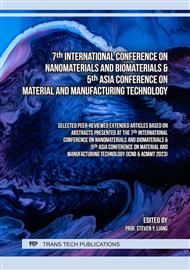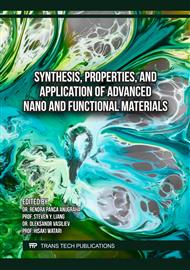[1]
J. Chen, J. J Bailey, L. Britnell, M. Perez-Pege, M. Sahoo, Z. Zhang, A. Strudwick, J. Hack, Z. Guo, Z. Ji, P. Martin, D. J. L. Brett, P. R. Shearing, and S. M. Holmes: Nano Energy Vol. 93 (2021), p.106829.
DOI: 10.1016/j.nanoen.2021.106829
Google Scholar
[2]
K. Cheng, S. Wallaert, H. Ardebili, and A. Karim: Carbon Vol. 194 (2022), p.81–103
Google Scholar
[3]
S. Verma, U. Dwivedi, K. Chaturvedi, N. Kumari, M. Dhangar, S. A. R. Hashmi, R. Singhal, and A. K. Srivastava: Synth. Met Vol. 287 (2022), p.117095
DOI: 10.1016/j.synthmet.2022.117095
Google Scholar
[4]
Z. Huang, H. Liu, R. Hu, H. Qiao, H. Wang, Y. Liu, X. Qi, and H. Zhang: Nano Today Vol. 35 (2020), p.100906
Google Scholar
[5]
M. P. Lavin-Lopez, A. Paton-Carrero, L. Sanchez-Silva, J. L. Valverde, and A. Romero: Adv. Powder Technol Vol. 28 (2017), p.3195–3203
DOI: 10.1016/j.apt.2017.09.032
Google Scholar
[6]
J. Wu, H. Lin, D. J. Moss, K. P. Loh, and B. Jia: Nat. Rev. Chem Vol. 7 (2023), p.162–183
Google Scholar
[7]
J. Singh, N. Jindal, V. Kumar, and K. Singh: Chem. Phys. Impact Vol. 6 (2023), p.100185
Google Scholar
[8]
N. Adrianto, N. I. Istiqomah, A. M. Panre, and E. Suharyadi: Solid State Phenom Vol. 332 (2022), p.85–90
Google Scholar
[9]
X. Weng, J. Wu, L. Ma, G. Owens, and Z. Chen: Chem. Eng. J Vol. 359 (2019), p.976–981
Google Scholar
[10]
K. Priyadharshini, S. Rathinavel, E. Velumani, and A. Manikandan: Mater. Today Proc Vol. 80 (2023), p.1341–1347
DOI: 10.1016/j.matpr.2023.01.085
Google Scholar
[11]
J. Khan and M. Jaafar: J. Mater. Sci Vol. 56 (2021), p.18477–18492
Google Scholar
[12]
G. Bhattacharya, S. Sas, S. Wadhwa, A. Mathur, J. McLaughlin, and S. S. Roy: RSC Adv Vol. 7 (2017), p.26680–26688
DOI: 10.1039/c7ra02828h
Google Scholar
[13]
M. Mahmudzadeh, H. Yari, B. Ramezanzadeh, and M. Mahdavian: J. Hazard. Mater Vol. 371 (2019), p.609–624
Google Scholar
[14]
S. Azhar, K. S. Ahmad, I. Abrahams, S. B. Jaffri, T. Ingsel, R. K. Gupta, and D. Ali: Ionics Vol. 29 (2023), p.2485–2500
DOI: 10.1007/s11581-023-05002-1
Google Scholar
[15]
N. M. S. Hidayah, W. W. Liu, C. W. Lai, N. Z. Noriman, C. S. Khe, U. Hashim, and H. C. Lee: AIP Conf. Proc Vol. 1892 (2017), p.150002
Google Scholar
[16]
S. Tajik, H. Beitollahi, S. A. Ahmadi, M. B. Askari, and A. Di Bartolomeo: Nanomaterials Vol. 11 (2021), p.3208
DOI: 10.3390/nano11123208
Google Scholar
[17]
N. S. Suhaimin, M. F. R. Hanifah, J. W. Jusin, J. Jaafar, M. Aziz, A. F. Ismail, M. H. D. Othman, M. A. Rahman, F. Aziz, N. Yusof, and R. Mohamud: Phys. E Low-Dimensional Syst. Nanostructures Vol. 131 (2021), p.114727
DOI: 10.1016/j.physe.2021.114727
Google Scholar
[18]
F. W. Low, C. W. Lai, and S. B. Abd Hamid: Ceram. Int Vol. 41 (2015), p.5798–5806
Google Scholar
[19]
A. Sharma, G. Erdenedelger, H. Mo Jeong, and B. K. Lee: J. Environ. Chem. Eng Vol. 8 (2020), p.103749
Google Scholar
[20]
Y. Han, Z. Xu, and C. Gao: Adv. Funct. Mater Vol. 23 (2013), p.3693–3700
Google Scholar
[21]
A. Hadi, J. Karimi-Sabet, S. M. A. Moosavian, and S. Ghorbanian: J. Supercrit. Fluids Vol. 107 (2016), p.92–105
Google Scholar
[22]
E. H. Sujiono, Zurnansyah, D. Zabrian, M. Y. Dahlan, B. D. Amin, Samnur, and J. Agus Heliyon Vol. 6 (2020), p. e04568
DOI: 10.1016/j.heliyon.2020.e04568
Google Scholar
[23]
R. Al-Gaashani, A. Najjar, Y. Zakaria, S. Mansour, and M. A. Atieh: Ceram. Int Vol. 45 (2019), p.14439–14448
DOI: 10.1016/j.ceramint.2019.04.165
Google Scholar
[24]
N. Azimi, A. Gandomkar, and M. Sharif: Polym. Bull Vol. 80 (2022), p.6455–6469
Google Scholar
[25]
M. Coros, F. Pogacean, A. Turza, M. Dan, C. B. Grosan, I. O. Pana, S. Pruneanu: Phys. E Low-Dimensional Syst. Nanostructures Vol. 119 (2020), p.113971
DOI: 10.1016/j.physe.2020.113971
Google Scholar
[26]
I. V. Popov, A. L. Görne, A. L. Tchougréeff, and R. Dronskowski: Phys. Chem. Chem. Phys Vol. 21 (2019), p.10961–10969
DOI: 10.1039/c8cp07592a
Google Scholar
[27]
N. Sharma, M. Arif, S. Monga, M. Shkir, Y. K. Mishra, and A. Singh: Appl. Surf. Sci Vol. 513 (2019), p.145396
Google Scholar



